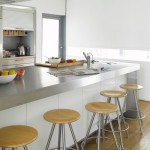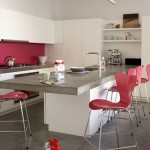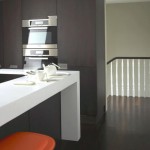I relish designing kitchens, but I find that clients tend to act like Jell-o when it comes to choosing a countertop material. So to help get the recipe right, here are (minus any further painful puns), the basics on countertops:
Butcher Block
Typically available in maple and oak, butcher blocks can look great in a cottage, but they somehow keep calling me back to the ’80s.
Pros: can cut on surface, can be sanded and resealed as necessary.
Cons: highly porous, requires regular treatments with mineral oil.
Caesarstone
Caesarstone, an engineered composite using quartz particles, is a relatively new kid on the block. I’ve used the darker grays and I think that they came out looking pretty cool.
Pros: virtually maintenance-free, resistant to staining and scorching.
Cons: expensive.
Concrete
Concrete is a great exotic material and can patina nicely over time, although I find it really tough to work with.
Pros: can be tinted, heat and scratch resistant.
Cons: expensive, can be prone to cracking.
Corian
Corian is a solid surface plastic material manufactured by Dupont. I’ve used the translucent white many times with great results.
Pros: invisible joints, easy to clean, relatively inexpensive and stain-resistant.
Con: not as durable as stone, easily scorched.
Marble
Marble lends a luxurious feel and is one of my favourite choices for countertops; it has a classic look and feel.
Pros: naturally more beautiful than granite.
Cons: softer than granite, chips more easily, can be stained by oils.
Stainless Steel
For those looking for an industrial contemporary look, stainless steel is an obvious choice, but I find it can be hard to clean without leaving streaks.
Pros: much sturdier than other surfaces, no chipping, non-porous, resists heat damage.
Cons: expensive, may dent.

Is the choice still as clear as mud? Please email me at [email protected] and hopefully I can steer you in the right direction.




